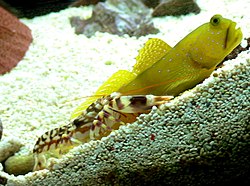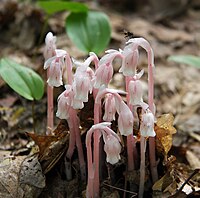Symbiosis

gobyfish keeps lookout
Symbiosis(pl. symbioses) means living together. It describes close and long-term relationships between differentspecies.The term was used byAnton de Baryin 1869, as "the living together of unlike organisms".[1][2][3]
Asymbiontis an organism living in a relationship with another species in which one or both get benefits.[4]When one species lives inside another species, or amicroscopicsymbiont lives inside thecellsof a host, it is called anendosymbiont.
The relevance of symbiosis is its frequency and itsevolutionarysignificance. There appear to be no higher plants or animals without symbionts. Those symbionts are of great importance to the larger organisms, who in most cases would be unable to live as they do without their symbionts.Mycorrhizain higher plants, andgut floraininsectsandvertebratesare examples. Humans are no exception.[5][6]
Furthermore, most of these associations are between organisms not just from different species, but from differentkingdoms.And lastly, the cells of alleukaryotescontainorganelleswhich are descendants of symbiotic relationships which began at least abillionyears ago.Mitochondriaandplastidsare examples. The conclusion must be that symbiosis has been highly significant in the evolution of life.
Definition
[change|change source]
The definition of symbiosis has been controversial. Some believe symbiosis should only refer to persistentmutualisms,while others believe it should apply to all kinds of long-term biological interactions.[7]
After 130 years of debate,[8]currentbiologyandecologytextbooks now use the latter "de Bary" definition or an even broader definition (where symbiosis means all species interactions). The restrictive definition (where symbiosis means mutualism only) is no longer used.[9]
The widest definition includesparasitism(in which oneorganismis helped and the otherorganismis hurt),mutualism(in which bothorganismsare helped),commensalism(in which oneorganismis helped and the other is not affected), andcompetition(in which bothorganismsare hurt).
Types of symbiosis
[change|change source]
The various forms of symbiosis include:
Type 1: Partners keep their bodies separate
[change|change source]Symbiosis does not always benefit both partners. This is what may happen:
- parasitism,in which the association has disadvantages for one of the two. One may even destroy or kill the other. (+ –)
- mutualism,in which the association has advantages for both (+ +)
- commensalism,in which one member of the association benefits while the other is not affected (+ 0)
- competition,in which both members of the association are fighting over food or other needs. (– –)
Type 2: Partners live as one organism
[change|change source]



This kind of symbiosis is calledendosymbiosis.Examples are:
- Rhizobia:nitrogen-fixingbacteriawhich live inrootnodules on plants of thepeafamily.
- Singly-celledforamswhich include a single-celledalgainside the cell. This is 'facultative', which means they may or may not do it. A more far-reaching version isidioplasticendosymbiosis. Here, the foram consumes the alga, but keeps itschloroplastsin working order.
- Green algaeinsidemarinepolychaeteworms.
- Single-celled algae insidereef-buildingcorals.
- Bacteriainside the guts of thoseinsectsandvertebrateswhich digest plantcellulose.These are 'obligate' symbionts, which means the host must have them.[11]
- Lichen:fungus+algaorbacterium.
- Mycorrhiza:fungalhyphaeandrootsoftrees.
Almost for certain, this happened to form theeukaryotecell.That's the type of cell all animals and plants are made of. Theorganellesinside the cell, such asmitochondriaandchloroplasts,contain some DNA. This DNA is the remnant of a once separatebacterium.The theory is that the eukaryote cell evolved by the fusion of several bacteria orarchaeaorganisms.[12][13][14][15]
Examples of symbiosis
[change|change source]- An example of mutual symbiosis is the relationship betweenclownfishthat live among thetentaclesof tropicalsea anemones.The clownfish protects the anemone from otherfish.Clownfish waste excreted provides vital nutrients, and they can boost their hosts’ oxygen supplies at night too. The stinging tentacles of the anemone protect the anemone fish from itspredators.A specialmucuson the clownfish protects it from the stinging tentacles.[16]
- Another example is thegoby fish,which sometimes lives together with ashrimp.The shrimp digs and cleans up a burrow in the sand in which both the shrimp and the goby live. The shrimp is almost blind, and is vulnerable to predators when above ground. When a predator approaches, the goby touches the shrimp with its tail as a signal. When that happens both the shrimp and goby quickly retreat into the burrow.
- Alichenis an intimate combination of afunguswith analga.The alga lives inside the fungus, which must have the alga to survive. The alga, on the other hand, can survive on its own. The result of the union is a flat, coloured lichen which grows on rocks and other surfaces in the open air.
- Herbivoresare host togutbacteriawhich help them digest plant material. Plant cell walls are made ofcellulose,and almost no animal has developed an enzyme to digest this material. Therefore, at least for herbivores which eat leaves, the bacteria are essential.
- Some species ofants'farm'aphids,protecting them from predators, and moving them from one feeding site to another. The ants consume the sweet sticky fluid which aphids secrete after sucking plantsap.
References
[change|change source]- ↑de Bary, Anton 1879. Die Erscheinung der Symbiosis. InVerlag auf der Versammlung der Naturforscher und Artze zu Cassel.Strassburg.
- ↑Schwendener, Simon 1868. Unter suchungen über den Flechtenthallus.Beiträge zur wissenschaftlichten Botanik6,195–207.
- ↑Crombie J.M. 1886. On the algae-lichen hypothesis.J Linn. Soc.21,259–282.
- ↑King R.C. Stansfield W.D. & Mulligan P.K. 2006.A dictionary of genetics,7th ed. Oxford.
- ↑Guarner F, Malagelada JR (2003). "Gut flora in health and disease".Lancet.361(9356): 512–9.doi:10.1016/S0140-6736(03)12489-0.PMID12583961.S2CID38767655.
- ↑Sears CL (2005). "A dynamic partnership: celebrating our gut flora".Anaerobe.11(5): 247–51.doi:10.1016/j.anaerobe.2005.05.001.PMID16701579.
- ↑Douglas, Angela E. (2010),The symbiotic habit,New Jersey: Princeton University Press, pp. 5–12,ISBN978-0-691-11341-8
- ↑Martin, Bradford D.; Schwab, Ernest (2012), "Symbiosis: 'Living together' in chaos",Studies in the History of Biology,4(4): 7–25
- ↑Martin, Bradford D.; Schwab, Ernest (2013), "Current usage of symbiosis and associated terminology",International Journal of Biology,5(1): 32–45,doi:10.5539/ijb.v5n1p32
- ↑Yang, S.; Pfister, D.H. (2006)."Monotropa unifloraplants of eastern Massachusetts form mycorrhizae with a diversity of russulacean fungi ".Mycologia.98(4): 535–540.doi:10.3852/mycologia.98.4.535.PMID17139846.
- ↑Buchner P. 1965.Endosymbioses of animals with plant microorganisms.Wiley N.Y.
- ↑Margulis, Lynn 1998.The symbiotic planet: a new look at evolution.Weidenfeld & Nicolson, London. Margulis believes symbiosis is the most important force in evolution.
- ↑Sapp J. 1994.Evolution by association: a history of symbiosis.Oxford. A balanced overview.
- ↑Khakhina L.N. 1992.Concepts of symbiogenesis: a historical and critical survey of the research of Russian botanists.Yale, New Haven CN.
- ↑Lake, James A. Evidence for an early prokaryote symbiogenesis.Nature460967–971.
- ↑Clownfish help their anemones breatheMarch 2, 2013The Economist
